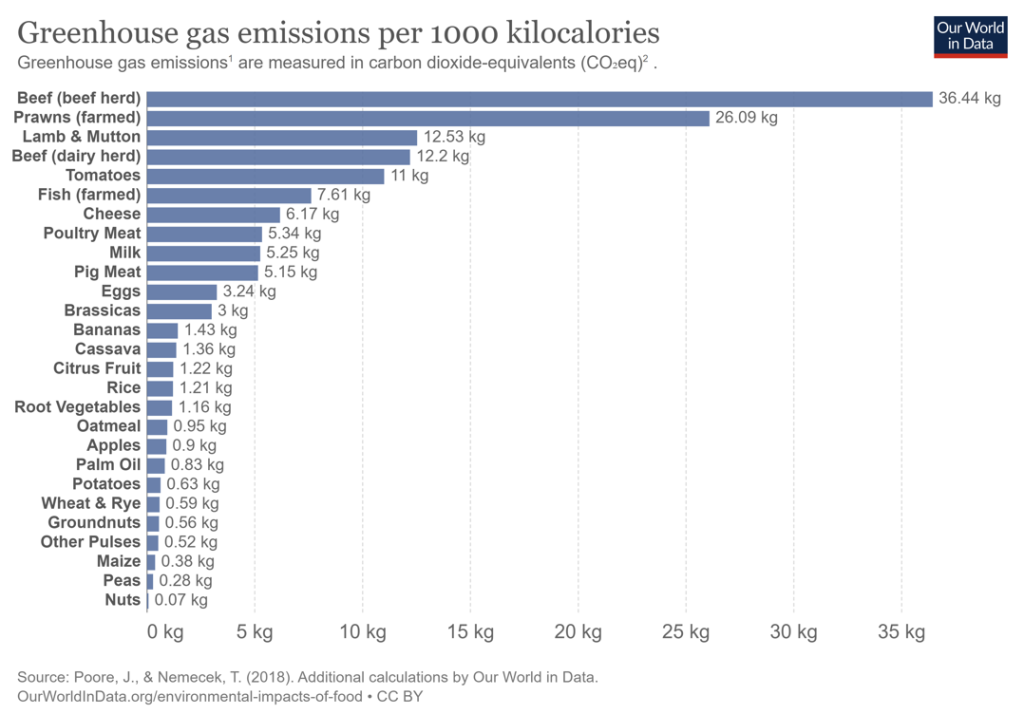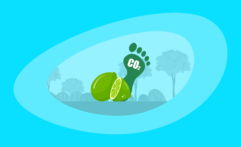What Is the Carbon Footprint of Raspberries? A Life-Cycle Analysis
Impactful Ninja is reader-supported. When you buy through links on our site, we may earn an affiliate commission.
Learn more
Learn more
.
Hey fellow impactful ninja ? You may have noticed that Impactful Ninja is all about providing helpful information to make a positive impact on the world and society. And that we love to link back to where we found all the information for each of our posts. Most of these links are informational-based for you to check out their primary sources with one click. But some of these links are so-called "affiliate links" to products that we recommend. First and foremost, because we believe that they add value to you. For example, when we wrote a post about the environmental impact of long showers, we came across an EPA recommendation to use WaterSense showerheads. So we linked to where you can find them. Or, for many of our posts, we also link to our favorite books on that topic so that you can get a much more holistic overview than one single blog post could provide. And when there is an affiliate program for these products, we sign up for it. For example, as Amazon Associates, we earn from qualifying purchases. First, and most importantly, we still only recommend products that we believe add value for you. When you buy something through one of our affiliate links, we may earn a small commission - but at no additional costs to you. And when you buy something through a link that is not an affiliate link, we won’t receive any commission but we’ll still be happy to have helped you. When we find products that we believe add value to you and the seller has an affiliate program, we sign up for it. When you buy something through one of our affiliate links, we may earn a small commission (at no extra costs to you). And at this point in time, all money is reinvested in sharing the most helpful content with you. This includes all operating costs for running this site and the content creation itself. You may have noticed by the way Impactful Ninja is operated that money is not the driving factor behind it. It is a passion project of mine and I love to share helpful information with you to make a positive impact on the world and society. However, it's a project in that I invest a lot of time and also quite some money. Eventually, my dream is to one day turn this passion project into my full-time job and provide even more helpful information. But that's still a long time to go. Stay impactful,Affiliate Disclosure
Why do we add these product links?
What do these affiliate links mean for you?
What do these affiliate links mean for us?
What does this mean for me personally?
![]()
Raspberries come in over 200 varieties, making them a diverse and popular fruit. Moreover, raspberry production is on the rise, with almost a million tons of the fruit being grown in 2021, an increase of 34% since 2011. But, there are many aspects of the raspberry production process that can be harmful to the planet. So we had to ask: What is the carbon footprint of raspberries?
Raspberries have a fairly low carbon footprint of 0.15kg (0.33lb) of CO2e per pound of raspberries. This footprint is mainly caused by their high-growth resources, including land use, irrigation, and pesticides. They also require plastic packaging and refrigerated transportation from Mexico.
In this article, we will look at the full life-cycle of raspberries, investigating how each stage contributes to their carbon footprint. We will go through all of the main stages of raspberries’ production—starting with growth and then going through harvesting, processing, transportation, and ending at waste disposal—and will evaluate how each stage contributes to raspberries’ carbon footprint. So, let’s get into the carbon footprint of raspberries!
Here’s How We Assessed the Carbon Footprint of Raspberries
The carbon footprint is one of the ways we measure the effects of our human-induced global climate change. It primarily focuses on the greenhouse gas (GHG) emissions associated with consumption, but also includes other emissions such as methane (CH4), nitrous oxide, and chlorofluorocarbons, and is generally expressed in carbon dioxide equivalents (CO2e).
“Carbon footprint: the amount of greenhouse gases and specifically carbon dioxide emitted by something (such as a person’s activities or a product’s manufacture and transport) during a given period”
Merriam Webster
Basically, it is the amount of carbon emitted by you as an individual or an organization providing you with goods and services – including raspberries:
- This includes GHG emissions from producing the products that we use and foods that we eat (e.g., power plants, factories or farms, and landfills)
- GHG emissions from fuel that we burn directly or indirectly (e.g., logistics and transportation, cooling or heating facilities),
- as well as the GHG emissions attributed to how we consume these products and foods.
To understand the carbon footprint of raspberries, we must assess their life-cycle and each stage’s sustainability. This life-cycle assessment (LCA) is a method to evaluate the environmental impacts of products and materials.
Here’s the Overall Carbon Footprint of Raspberries
The overall carbon footprint of raspberries is 0.15kg (0.33lb) of CO2e per pound of raspberries. The main factors that contribute to this footprint are their low yields per hectare, irrigation requirements, high pesticide use, plastic packaging, and refrigerated transportation.
Raspberries have a low carbon footprint overall because they are manually harvested and processed in North America and have no natural waste. However, they also have many factors that contribute significantly to their carbon footprint, such as transportation.
| The carbon footprint of raspberries | 0.15kg (0.33lb) of CO2e per pound of raspberries |
So, let’s have a look at each stage of the LCA of raspberries!
| The life-cycle stages of raspberries | Each stage’s carbon footprint |
| Growing of raspberries | The carbon footprint of growing raspberries is high. This is mainly because of their low yield per hectare, high irrigation requirements, and excessive use of pesticides. |
| Harvesting, processing, and packaging of raspberries | The carbon footprint of harvesting, processing, and packaging raspberries is moderate. This is mainly due to their use of plastic packaging, even though the harvesting and processing is manual. |
| Transporting of raspberries | The carbon footprint of transporting raspberries is moderate-high. This is mainly because they have to come from Mexico and are transported in emission-high refrigerated trucks. |
| End-of-life of raspberries | The carbon footprint of the end-of-life of raspberries is fairly high. This is mainly because of their very short shelf life leading to increased waste, as well as their use of plastic packaging. |
The stage that contributes the most to raspberries’ carbon footprint is the growth period, mainly because of the higher-than-average resources needed to grow raspberries. The next highest stages are transportation and end-of-life, which are high because of long distances and plastic packaging, respectively. The lowest is the harvesting stage, mainly because raspberries use low-emission manual harvesting and processing methods.
What Is the Carbon Footprint of Growing Raspberries
The carbon footprint of growing raspberries is high. This is mainly because of their low yield per hectare, high irrigation requirements, and excessive use of pesticides.
The process of growing raspberries generally has a high carbon footprint, depending on the methods used. Factors like the amount of irrigation, deforestation, and pesticide use can all contribute to the overall impact of the growth stage.
Which factors impact the carbon footprint of growing raspberries?
- How do raspberries grow: Raspberries are grown on bushes in fields. These bushes can sequester carbon, which is excellent news because this can offset some of their own emissions. Thus, the growth method doesn’t contribute significantly to raspberries’ overall carbon footprint.
- What is the growth duration of raspberries: The longer the growth frame, the higher the carbon footprint because more resources are required to sustain the plants. A raspberry bush will take two years to mature so they can produce fruit. For individual raspberries, they will take around 1–2 months to go from flower to fruit. These time frames are on the lower end, so the growth duration does not contribute significantly to raspberries’ overall carbon footprint.
- What is the land usage of raspberries: When fruits use less land, they require less deforestation and resources to sustain them. Raspberries yield around 5 tons of fruit per hectare. This is on the very low end of fruits, and so this stage contributes significantly to their overall carbon footprint.
- What is the water usage of raspberries: Raspberries need about an inch of water a week. Most raspberries consumed in the US come from Mexico. Mexico’s average annual rainfall is only around 28 inches per year. Thus, raspberries need significant irrigation. Irrigation has a high carbon footprint and so this stage contributes significantly to raspberries’ overall carbon footprint.
- What is the pesticide and fertilizer usage of raspberries: Raspberries were included in a list of the top pesticide users. Pesticides create a significant amount of emissions. Therefore, this stage does contribute to the overall carbon footprint.
Many aspects of growing raspberries have a very high carbon footprint. Their low-density yields, need for irrigation, and high pesticide use are all major carbon offenders that raise their carbon footprint significantly.
In short, growing raspberries has a high carbon footprint. The main factors that go into this higher footprint are their significant land use per pound of raspberries, their need for irrigation, and their higher-than-average use of pesticides.
What Is the Carbon Footprint of Harvesting, Processing, and Packaging Raspberries
The carbon footprint of harvesting, processing, and packaging raspberries is moderate. This is mainly due to their use of plastic packaging, even though the harvesting and processing is manual.
The next major stage in the life-cycle of raspberries’ carbon emissions is harvesting, processing, and packaging. This involves picking the fruit, checking it for damage, sorting it, and getting it ready for distribution. This stage can contribute greatly to the carbon footprint of the fruit depending on the processes used.
Which factors impact the carbon footprint of harvesting, processing, and packaging raspberries?
- How are raspberries harvested: Fresh raspberries are harvested by hand because of their delicate skins. Since hand harvesting does not require any direct energy, this stage contributes minimally to raspberries’ carbon footprint.
- How are raspberries processed: Raspberries are packed in the field as they are picked. This cuts down on a lot of mechanization present in other fruits. Thus, this stage contributes minimally to raspberries’ carbon footprint.
- How are raspberries packaged: Raspberries are typically packaged in plastic clamshells. Since plastic creates a high amount of emissions during its production process, this stage contributes significantly to raspberries’ carbon footprint.
Much of the harvesting, processing, and packaging stage of raspberries is very low carbon due to the manual harvesting and processing. However, the use of plastic packaging brings the footprint of this stage from low to moderate.
In short, harvesting, processing, and packaging raspberries has a moderate carbon footprint. The main factor raising its carbon footprint at this stage is the use of plastic packaging.
What Is the Carbon Footprint of Transporting Raspberries
The carbon footprint of transporting raspberries is moderate-high. This is mainly because they have to come from Mexico and are transported in emission-high refrigerated trucks.
Raspberries’ journeys have just started when they are packaged. They then have to travel the distance between the farm and the grocery store. The distance, as well as the method through which they have to travel, are the two most important factors in determining the carbon footprint of their transportation.
Which factors impact the carbon footprint of transporting raspberries?
- Where are raspberries grown: Around 75% of American-consumed raspberries are grown in Mexico. Thus, the vast majority of raspberries are being trucked across the border. This isn’t as high a transportation cost as those that might come from, say, Europe or Asia, but it is still more than domestic fruit. Therefore, this stage has a moderate carbon footprint.
- How are raspberries transported: Raspberries have an incredibly short shelf life which means that they need to be stored at very cool temperatures for the duration of their transportation journey. So, they are primarily transported in refrigerated trucks. Refrigerated trucks use more fuel than unrefrigerated trucks, and thus this stage contributes significantly to raspberries’ carbon footprint.
The fact that raspberries have to travel a considerable distance and have to be refrigerated while doing so means that their travel carbon footprint is significant. It is not the highest it could be, but it is still moderately high.
In short, the moderately high transportation distances and the use of refrigeration in their transportation methods mean that transporting raspberries has a moderate to high carbon footprint.
What Is the Carbon Footprint of the End-of-Life of Raspberries
The carbon footprint of the end-of-life of raspberries is fairly high. This is mainly because of their very short shelf life leading to increased waste, as well as their use of plastic packaging.
Raspberries’ carbon footprint journey isn’t done after you consume them. In fact, one of the most important factors that will determine the overall carbon footprint of raspberries is how their waste is disposed of. Here, we will look at how this stage in the process affects raspberries’ carbon footprint.
Which factors impact the carbon footprint of the end-of-life of raspberries?
- How are raspberries disposed of: Raspberries don’t have any peels or pits that get thrown away. However, raspberries have some of the shortest shelf lives among fruits, and so they are more likely to go bad and discarded. Furthermore, food waste is particularly harmful to the environment as it releases a greenhouse gas called methane when it is put in landfills. Thus, this stage contributes moderately to raspberries’ carbon footprint.
- How is the packaging of raspberries disposed of: Raspberries use primarily plastic packaging, which is bad news for their carbon footprint. Plastic has an incredibly low recycling rate of around 9%. So, the majority of plastic waste is going into landfills, causing this stage to contribute significantly to raspberries’ overall carbon footprint.
Raspberries don’t theoretically produce a lot of waste. However, the fact that they have an incredibly short shelf life and use plastic packaging means that in practice they do contribute significantly to landfills.
In short, raspberries tend to be thrown out more than other fruits because they go bad very easily. Pair that with their use of plastic packaging, and their waste carbon footprint becomes significant.
How Does the Carbon Footprint of Raspberries Compare to Other Types of Food
Amongst foods, berries generally have a moderate carbon footprint. Although raspberries rank low amongst berries, their lower calorie density results in their kilocalorie carbon footprint being higher.
Raspberries have a moderate carbon footprint in relation to other foods, especially when kilocalories are taken into account. When assessing the carbon footprint of a particular food, it is always important to place it in the context of other foods. This can help you to see the relative impact they have and assist you in making decisions between different foods based on their carbon footprint. In this next part of the article, we will show you how raspberries compare to other foods in terms of carbon footprint.
How Does the Carbon Footprint of Raspberries Compare to Other Types of Fruits
Raspberries have a lower carbon footprint when compared to other fruits. Fruits in general, tend to have lower carbon footprints than many other foods, like dairy products. However, there is still a lot of variation between them. Different transportation distances, the density of orchards, variations in growing methods, and pesticide use can all add up to contribute to their carbon footprints. Here, we will look at how raspberries compare specifically to other fruits in terms of carbon footprint.
| Fruits | Carbon Footprint per lbs | Calories per lbs | Carbon Footprint per Calories |
| Avocados | 0.85 kg (1.9 lb) of CO2e per pound of avocados | 725 calories per pound | 1.17kg (2.57lb) of CO2e per 1,000 calories of avocados |
| Grapes | 0.64 kg (1.42 lbs) of CO2e per pound of grapes | 300 calories per pound | 2.13kg (4.7lb) of CO2e per 1,000 calories of grapes |
| Cantaloupes | 0.58kg (1.3lb) of CO2e per pound of cantaloupe | 154 calories per pound | 3.77kg (8.31lb) of CO2e per 1,000 calories of cantaloupes |
| Kiwis | 0.56kg (1.24lb) of CO2e per pound of kiwis | 277 calories per pound | 2.02kg (4.45lb) of CO2e per 1,000 calories of kiwis |
| Blueberries | 0.45kg (1lb) of CO2e per pound of blueberries | 256 calories per pound | 1.75kg (3.86lb) of CO2e per 1,000 calories of blueberries |
| Plums | 0.4 kg (0.88 lb) CO2e per pound of plums | 209 calories per pound | 1.91kg (4.21lb) of CO2e per 1,000 calories of plums |
| Strawberries | 0.39kg (0.88lb) of CO2e per pound of strawberries | 145 calories per pound | 2.69kg (5.93lb) of CO2e per 1,000 calories of strawberries |
| Pomegranates | 0.39kg (0.87lb) of CO2e per pound of pomegranates | 375 calories per pound | 1.04kg (2.29lb) of CO2e per pound of pomegranates |
| Figs | 0.3kg (0.68lb) of CO2e per pound of figs | 333 calories per pound | 0.9kg (1.98lb) of CO2e per 1,000 calories of figs |
| Papayas | 0.3kg (0.67lb) of CO2e per pound of papayas | 195 calories per pound | 1.54kg (3.4lb) of CO2e per 1,000 calories of papayas |
| Oranges | 0.3kg (0.66 lb) CO2e per pound of oranges | 213 calories per pound | 1.41kg (3.11lb) of CO2e per 1,000 calories of oranges |
| Dates | 0.27kg (0.6lb) of CO2e per pound of dates | 1,300 calories per pound | 0.21kg (0.46lb) of CO2e per 1,000 calories of dates |
| Apples | 0.24 kg (0.53 lb) of CO2e per pound of apples | 236 calories per pound | 1.02kg (2.25lb) of CO2e per 1,000 calories of apples |
| Pears | 0.23kg (0.52 lb) of CO2e per pound of pears | 259 calories per pound | 0.89kg (1.96lb) of CO2e per 1,000 calories of pears |
| Bananas | 0.21 kg (0.48 lb) of CO2e per pound of banana | 404 calories per pound | 0.52kg (1.15lb) of CO2e per 1,000 calories of bananas |
| Mangoes | 0.21 kg (0.46 lb) CO2e per pound of mangoes | 272 calories per pound | 0.77lb (1.7lb) of CO2e per 1,000 calories of mangoes |
| Cherries | 0.19kg (0.41 lb) of CO2e per pound of cherries | 227 calories per pound | 0.84kg (1.85lb) of CO2e per 1,000 calories of cherries |
| Limes | 0.18kg (0.39lb) of CO2e per pound of limes | 136 calories per pound | 1.32kg (2.91lb) of CO2e per 1,000 calories of limes |
| Peaches | 0.17kg (0.38lb) CO2e per pound of peaches | 176 calories per pound | 0.97kg (2.14lb) of CO2e per 1,000 calories of peaches |
| Apricots | 0.16kg (0.36lb) of CO2e per pound of apricots | 218 calories per pound | 0.73kg (1.61lb) of CO2e per 1,000 calories of apricots |
| Raspberries | 0.15kg (0.33lb) of CO2e per pound of raspberries | 240 calories per pound | 0.63kg (1.39lb) of CO2e per 1,000 calories of raspberries |
| Pineapples | 0.09 kg (0.20 lb) of CO2e per pound of pineapple | 227 calories per pound | 0.4kg (0.88lb) of CO2e per 1,000 calories of pineapples |
| Lemons | 0.09kg (0.19lb) CO2e per pound of lemons | 132 calories per pound | 0.68kg (1.5lb) of CO2e per 1,000 calories of lemons |
| Grapefruit | 0.08kg (0.18lb) of CO2e per pound of grapefruit | 191 calories per pound | 0.42kg (0.93lb) of CO2e per 1,000 calories of grapefruits |
| Blackberries | 0.07kg (0.15lb) of CO2e per pound of blackberries | 195 calories per pound | 0.36kg (0.79lb) of CO2e per 1,000 calories of blackberries |
| Clementines | 0.06 kg (0.13 lb) CO2e per pound of clementines | 213 calories per pound | 0.28kg (0.62kg) of CO2e per 1,000 calories of clementines |
| Watermelons | 0.05kg (0.11 lb) of CO2e per pound of watermelon | 136 calories per pound | 0.37kg (0.82lb) of CO2e per 1,000 calories of watermelons |
Raspberries fall fairly low on the ranking of fruit carbon footprints. They are well below the average of 0.26 and have ⅕ of the emissions of avocados, the worst carbon offender. However, they are still significantly higher than some of the lower offenders, with 1.5 times the emissions of pineapples and 3 times the emissions of clementines. So, while they do rank low amongst fruits, there are still some that have significantly fewer emissions.
How Does the Carbon Footprint of Raspberries Compare to Other Types of Food in General
Branching outside the world of fruit, raspberries have a somewhat high footprint among food in general, especially when grouped in with other berries. In terms of their carbon footprint including kilocalories, they have a moderate carbon footprint compared to other foods.
When it comes to greenhouse gas emissions (GHG), foods are often compared in terms of emissions per 1,000 kilocalories (as opposed to their weight in lbs or kg).

Berries in general rank moderately on the scale of foods, being the highest fruits on this chart.
- This is mainly because when you take kilocalories into account, raspberries are less calorie efficient.
- They only pack around 240 calories per pound, whereas bananas pack around 400.
- Thus, raspberries are going to produce less calorie value for their carbon footprints than bananas.
- For this reason, they rank higher on the scale of foods when kilocalories are taken into account.
How Can You Reduce and Offset Your Personal Carbon Footprint
There are many things you can do to cut down on how your raspberry consumption impacts the planet. By carefully considering your consumption habits to reduce carbon emissions and offsetting your carbon through carbon-extraction schemes, you can consume raspberries without having a large negative impact on the earth.
Some of the carbon risks of raspberries highlighted in this article may sound a bit alarming, especially since their carbon footprint is fairly high. However, the good news is that there are a lot of things you can do to lower your carbon emissions while still eating raspberries. Purchasing organic or locally grown raspberries and disposing of the waste efficiently can help with this. Furthermore, you can consider emission offsets, which work to extract carbon from the atmosphere. Here, we will walk you through how to accomplish both of these things.
How Can You Reduce Your Carbon Footprint When Shopping for Raspberries
Before you start worrying about your offsets, you might be wondering how you can stop producing carbon in the first place through your raspberry consumption. One of the best ways to do this is to look at the parts of the raspberry process that have the highest carbon footprint and start there. In this section, we give you a short list of ways you can reduce your raspberry carbon footprint, so you can continue consuming raspberries without the high carbon price tag.
- Buy domestic raspberries: A major contributor to raspberries’ carbon footprint is the fact that they need to be brought in from Mexico. Fortunately, there are lots of raspberry farms in the US, primarily on the West Coast. If you make a point of buying from US, or even more local, raspberry farms, then you will be greatly reducing the transportation component of your carbon footprint.
- Buy organic raspberries: Another major contributor to raspberries’ carbon footprint is their high pesticide use. If you buy raspberries from an organic farm, which don’t use chemicals like pesticides, then you will be reducing your pesticide carbon footprint.
- Consume your raspberries as soon as possible: The low shelf life of raspberries means that they tend to be thrown out more often than other fruits. If you make the effort to eat your raspberries as soon as you buy them, you will mitigate the risk that they will end up in a landfill.
- Avoid plastic packaging: Although most raspberries come in plastic clamshells, there are still some that come in cardboard cartons. Cardboard still has a carbon footprint, but it is more widely recycled than plastic and can even be composted. Thus, you will be reducing your waste carbon footprint if you choose cardboard over plastic packaging.
Following some of these methods can really help you to cut down on your raspberry carbon emissions. None of these will bring your emissions down to zero, since there are always hidden carbon costs that may be outside of your control. But reduction is always better than nothing! However, if you do want to get your raspberry emissions down to absolute zero, then you can look into carbon offsets.
How Can You Offset Your Personal Carbon Footprint
Carbon offsets are reductions in carbon emissions that are used to compensate for carbon emissions occurring elsewhere – for example for the carbon emissions that are associated with raspberries. They are measured in tons of CO2 equivalents and are bought and sold through international brokers, online retailers, and trading platforms on what is known as the global carbon offset market.
“Carbon Offset: a way for a company or person to reduce the level of carbon dioxide for which they are responsible by paying money to a company that works to reduce the total amount produced in the world, for example by planting trees”
Oxford Dictionary
In terms of raspberries – and indeed all food types – there will always be a carbon footprint, because of the resources it takes to get your food from farms to the place where you’ll eventually eat them. And while there are ways to reduce your carbon footprint when shopping for raspberries, carbon offsets would be a way to reduce your CO2e emissions all the way down to net zero (or even to become climate positive).
However, when you purchase carbon offsets, it’s important that they actually make a difference in offsetting (aka reducing) total carbon emissions. To achieve that, the following are key criteria:
- Carbon offset projects have to be effective (different projects have different effectiveness rates)
- Carbon offset projects have to be additional
- Carbon offset projects have to be permanent
- The claims from carbon offset projects have to be verifiable
To find the best carbon offsets for you personally, check out our full guide on the best carbon offsets for individuals, where you’ll also learn more about how these carbon offset projects work, what their respective offsetting costs are, and what your best way would be to offset your own carbon emissions.
Final Thoughts
Raspberries are a very carbon-conscious fruit when compared to others on the market. However, there are still some aspects of their production that lead to emissions. Their higher growth resources, transportation distances, and packaging should be taken into account. If you follow some of the reduction methods, such as buying local and organic, or reducing packaging, you can help mitigate some of these emissions and consume raspberries with a clearer carbon conscience!
Stay impactful,

Sources
- AG Hires: Refreshing Raspberry Facts
- Helgilibrary: Which Country Produces the Most Raspberries
- Britannica: Carbon footprint
- Science Direct: Life-cycle assessment (LCA)
- MIT SMR: Strategic Sustainability Uses of Life-Cycle Analysis
- UCLA: Carbon Footprints of Foods
- Extension: Raspberry Production
- International Agrophysics: New Biochars From Raspberry and Potato Stems Absorb More Methane
- BHG: How to Grow Raspberries
- Home Guides: How Long Do Raspberry Bushes Take to Produce
- Statistica: Yearly Estimated Yield of Raspberries
- Home Guides: How to Water Raspberries
- Raspberry Blackberry: Where Do Your Berries Come From
- Climate Knowledge Portal: Mexico Climate Data
- Science Direct: Energy and Carbon Footprints for Irrigation
- Down to Earth: The Dirty Dozen
- Pesticide.org: Pesticides and the Climate Crisis
- Rubus: Postharvest Handling and Storage of Blackberries and Raspberries
- ABC News: Berry Growers to Fully Commit to Recyclable Packaging
- Cargo and Hook: Strawberries and Raspberries
- Glacier Vehicles: How Much Fuel Does a Refrigerated Truck Consume?
- BC.GOV: Food and Organic Waste
- Also Known As: 12 Interesting Facts About Packaging Waste
- Impactful Ninja: What is the Carbon Footprint of Avocados
- Helabel: Kiwis
- Impactful Ninja: What is the Carbon Footprint of Blueberries
- Impactful Ninja: What is the Carbon Footprint of Plums
- Impactful Ninja: What is the Carbon Footprint of Strawberries
- Impactful Ninja: What is the Carbon Footprint of Oranges
- Impactful Ninja: What is the Carbon Footprint of Apples
- Impactful Ninja: What is the Carbon Footprint of Pears
- Impactful Ninja; What is the Carbon Footprint of Bananas
- Impactful Ninja: What is the Carbon Footprint of Mangoes
- Impactful Ninja: What is the Carbon Footprint of Cherries
- Impactful Ninja: What is the Carbon Footprint of Peaches
- Impactful Ninja; What is the Carbon Footprint of Pineapples
- Impactful Ninja: What is the Carbon Footprint of Lemons
- Impactful Ninja; What is the Carbon Footprint of Clementines
- Impactful Ninja: What is the Carbon Footprint of Watermelons
- Our World in Data: Greenhouse Gas Emissions per 1000 kilocalories
- Food Data Central: Raspberries Raw
- USDA: Bananas
- AGMRC: Raspberries
- Consumer Ecology: Carbon Footprint of a Cardboard Box
- Gardening Know How: Composting Cardboard
- Impactful Ninja: Best Carbon Offsets for Individuals




